2019 National Household Education Survey (NHES) Web Usability Testing Spanish Materials Update
NCES Cognitive, Pilot, and Field Test Studies System
Attachment 2 & 3 - NHES 2019 Usability Testing Screener & Protocols
2019 National Household Education Survey (NHES) Web Usability Testing Spanish Materials Update
OMB: 1850-0803
2019 National Household Education Survey (NHES) Web Usability Testing
Attachment 2 & 3
Attachment 2 Recruitment Screener [English and Spanish]…..p.2
Attachment 3 – Protocol Materials…..p.17
OMB# 1850-0803 v.236
(revised v.234)
National Center for Education Statistics (NCES)
June 2018
revised September 2018
Attachment 2 Recruitment Screener [English and Spanish]
NHES: 2019 Usability Testing
Hello. My name is [XXXXXX] and I work for the U.S. Census Bureau. The U.S. Department of Education is conducting a study about children’s care and education. The Census Bureau is assisting with the research.
We are looking for adult volunteers to help us improve the web survey used in this study. We want to know how easy or hard it is to complete the web survey, and we need help from people like you to do that. The information gained from the study will be used for potential revisions to the web survey. Your participation is voluntary, and you will receive no sales pitches or follow-up calls based on your participation. I’d like to ask you a few questions to see if you qualify for the study.
Collect code if offered (English only): _______________________________
What is your name? (write in First and Last name in separate fields)
________________________________________________
What is your daytime phone number?
(Probe for all 3: mobile, home (if not mobile), and work (if any))
_________________________________________________
How many people age 18 or older currently live in your household, INCLUDING yourself?
[ ]
How many people younger than 18 currently live in your household?
[ ]
Are you a parent or guardian of any children who are in Kindergarten to 12th grade?
Yes
No
Name or Initials |
Grade (K-12 or no grade) |
How old is this child? |
Is this child male or female? |
Is this child attending a public school? (Y or N) |
Is this child attending a private school? (Y or N) |
Is this child homeschooled for grades equivalent to K to 12th? (Y or N) |
Is this child attending a combination of homeschooling and other schooling? (Y or N) then Please explain the combination of schooling the child receives. (400 character field) |
|
|
|
|
|
|
|
|
|
|
|
|
|
|
|
|
|
|
|
|
|
|
|
|
Are you a parent or guardian of any children not yet in Kindergarten?
Yes (Go to Check)
No (Go to Check)
Name or Initials |
Is this child NOT YET in kindergarten? (Y or N)
|
How old is this child? |
Is this child male or female? |
Is this child in a care arrangement, e.g., family day care, day-care center, preschool, prekindergarten, Head Start or other early childhood program? (Y or N) Please explain the type of caregiving arrangement the child is in. (400 characters) |
|
|
|
|
|
|
|
|
|
|
|
|
|
|
|
CHECK: If no children, then thank and terminate call for NHES. If children, determine if they meet the current recruiting needs and then either proceed or thank and terminate call for NHES.
ASK/CONFIRM IF NOT OBVIOUS: Are you male or female?
o Male
o Female
In what year were you born? (write in)
________
Are you Hispanic, Latino, or Spanish origin?
o Yes
o No
o Prefer not to answer
What is your race? Please select one or more. White, Black or African American, American Indian or Alaska Native, Asian, or Native Hawaiian or other Pacific Islander?
American Indian or Alaska Native
Asian
Black or African American
Native Hawaiian or other Pacific Islander
White
Prefer not to answer
What is the highest grade of school you have completed, or the highest degree you have received? (do not read categories)
o Less than High School
o High School Graduate
o Some College, no degree
o Associate’s degree (AA/AS)
o Bachelor’s degree (BA/BS)
o Post-Bachelor's degree (For example MA, MS, Ph.D., JD, etc.)
Are you working for pay full-time, part-time, or are you not working for pay at this time?
o Full-time
o Part-time
o Not working for pay at this time SKIP TO Q13
a.
What is your current job title or job description?
_________________________________________________
Are you employed by the Federal Government? (if federal contractor, mark NO)
o Yes
o No
In what city, state, and ZIP code do you currently live?
![]()
Do you own a cell phone?
o Yes
o No Skip to Q15
Some cell phones are called “smartphones” because of certain features they have. Is your cell phone a smartphone, such as an iPhone, Android, Blackberry, or Windows phone, or are you not sure?
o Yes
o No
o Not sure
What type of smartphone do you have?
o iPhone
o Android
o Blackberry
o Windows phone
o Not sure
Do you own a desktop or laptop computer, or both?
o Desktop computer
o Laptop computer
o Both desktop and laptop computer
o Neither
Do you own a tablet computer such as an iPad, Samsung Galaxy Tab, Google Nexus, or Kindle Fire?
o Yes
o No
Do you have at least one year of Internet experience?
o Yes
o No SKIP TO Q18
a. How often do you use the Internet either on a computer or on a mobile device like a smartphone or tablet? Several times a day, about once a day, a few times a week, a few times a month, or a few times a year?
o Several times a day
o About once a day
o A few times a week
o A few times a month
o A few times a year
o Not at all [do not read to respondent]
b. Name two things you do on the Internet besides e-mail.
[ ]
[ ]
Internet Activity #1:
Research
Social media/communication (Facebook, Twitter, Craigslist)
Shopping
Banking or paying bills online
Music / movies / videos
Gaming
News
Travel (directions/reservations)
Employment
Other
Internet Activity #2:
Research
Social media/communication (Facebook, Twitter, Craigslist)
Shopping
Banking or paying bills online
Music / movies / videos
Gaming
News
Travel (directions/reservations)
Employment
Other
How did you hear about this research opportunity?
[ ] E-mail link
[ ] Census Bureau employee
[ ] Friend or family member (but not a Census Bureau employee)
[ ] Craigslist
[ ] Google advertisement
[ ] Flyer
[ ] Newspaper advertisement
[ ] Other – specify [ ]
Is your household’s annual income…?
o Less than $15,000?
o $15,000 to $25,000?
o $25,000 to$50,000?
o $50,000 to $100,000?
o More than $100,000?
Are you a U.S. citizen? You do not have to be a U.S. citizen to participate in our studies.
o Yes
o No - cannot come to headquarters
Have you participated in a research study or focus group in the past 6 months? (RECRUIT NONE.)
Yes (Thank and terminate.)
No (Continue)
What is the email address we should use when sending directions to our office, should you qualify for a study? (write in)
_________________________________________________
All recruits MUST be articulate, able to answer open ended questions, have at least one year of Internet experience, have a child that fits into the needed recruiting criteria, and able to provide explanations for their responses.
Based on your answers, we would like to invite you to participate in an interview session (to discuss your child’s care and education). You will receive $60 as a thank you for completing the interview. The interview is about 90 minutes in length and will be conducted (at the U.S. Census Bureau headquarters in Suitland, Maryland or at a local library or community center).
English sessions:
Are you willing to come to Suitland, Maryland to the Census Bureau headquarters for the session?
-
o Yes
(CONTINUE)
o No
(participant prefers other location – gather general location that would work for participant and CONTINUE)
English and Spanish:
[If they use a Smartphone, ask] So that we can see how you use the online survey, we would like for you to bring your smartphone with you to the study session.
(if willing to come to Suitland) Will you be willing to use your data on your phone to conduct the survey as the Census Bureau cannot provide WiFi?
-
o Yes
(CONTINUE)
o No
(schedule either offsite at a library or use a laptop)
[If they are in the laptop condition tell them] We will provide a laptop on site for you to use.
We are conducting interviews between __________ and ___________. Are you available to participate in this research study?
-
o Yes
(CONTINUE AND GIVE DIRECTIONS)
O No
(THANK AND TERMINATE)
RECRUITER: Check off all of the criteria this adult meets in order to categorize the interviews we will conduct.
Interview Criteria:
Parent of K-12 child public |
Parent of K-12 child private |
Parent of child < 6 NOT enrolled in school |
Parent of homeschool child (K-12 equivalent) |
Parent of homeschool child who also attends another school (K-12 equivalent) |
Not eligible for topical (no eligible children) |
|
|
|
|
|
|
|
Buenos días/buenas tardes/buenas noches. Me llamo [XXXXXX] y trabajo para la Oficina del Censo de los Estados Unidos. El Departamento de Educación de los Estados Unidos está llevando a cabo un estudio acerca del bienestar y educación de niños. La Oficina del Censo de los Estados Unidos está ayudando con el estudio.
Buscamos voluntarios adultos para ayudar mejorar la encuesta en internet usada en este estudio. Queremos saber que tan fácil o difícil es para completar la encuesta en internet, y necesitamos la ayuda de gente como usted. La información adquirida en este estudio puede ser usada para mejorar la encuesta en internet. Su participación es voluntaria, y no recibirá ni propuestas de venta ni llamadas de seguimiento después de su participación. Me gustaría hacerle algunas preguntas para ver si califica para el estudio.
Recompila el código si ofrecida: _______________________________
Es usted padre o tutor legal de algún niño que está en el grado Kínder hasta 12?
Si
No
Cuál es el nombre o cuales son las iniciales de [este niño/esta niña]? |
En qué grado está [este niño/esta niña]? (K-12 or no grade) |
Cuantos años tiene [este niño/esta niña]? |
Es de sexo masculino o femenino [este niño/esta niña]? |
Asiste [este niño/esta niña] a una escuela pública? (S o N) |
Asiste [este niño/esta niña] a una escuela privada? (S o N) |
¿Recibe [este niño/esta niña] enseñanza académica en el hogar equivalente a grados kínder hasta 12? (S o N) |
¿Asiste [este niño/esta niña] a una combinación de escuela pública y enseñanza académica en el hogar? (S o N) Por favor explique la combinación de educación que recibe. |
|
|
|
|
|
|
|
|
|
|
|
|
|
|
|
|
|
|
|
|
|
|
|
|
Es usted padre o tutor legal de algún niño que aún no empieza Kínder?
Si (Go to Check)
No (Go to Check)
Cuál es el nombre o las iniciales de [este niño/ esta niña]? |
Aun no está matriculado en kínder [este niño/esta niña]? (S o N)
|
Cuantos años tiene [este niño/ esta niña]? |
Es de sexo masculino o femenino [este niño/esta niña]? |
Está [este niño/ esta niña] en un arreglo de cuidado de niños, por ejemplo, cuidado en un hogar particular, un centro de cuidado infantil, pre-escolar, pre-kínder, Head Start u otro programa de primera infancia? (Yes/No) Por favor explique el tipo de arreglo de cuidado infantil en que participe. |
|
|
|
|
|
|
|
|
|
|
|
|
|
|
|
Basado en sus respuestas, nos gustaría invitarle a participar en una entrevista (para hablar sobre la educación y cuidado de su hijo(a)). Usted recibirá $60 para demonstrar nuestro agradecimiento por completar la entrevista. Le entrevista dura acerca de 90 minutos y tomará lugar en _______.
[If they use a Smartphone, ask] Para que podamos observar como utiliza la encuesta por internet, nos gustaría que trajera su teléfono celular al estudio.
¿Estará usted dispuesto(a) a usar sus datos en su teléfono celular para completar la encuesta? La Oficina del Censo de los Estados Unidos no puede disponer wifi.
-
o Yes
(CONTINUE)
o No
(schedule using a laptop)
[If they are in the laptop condition tell them] Le proporcionaremos una computadora portátil para que use en el sitio.
Llevamos a cabo las entrevistas entre __________ y ___________. ¿Está usted disponible para participar en este estudio durante esos días?
-
o Yes
(CONTINUE AND GIVE DIRECTIONS)
O No
(THANK AND TERMINATE)
RECRUITER: Check off all of the criteria this adult meets in order to categorize the interviews we will conduct.
Interview Criteria:
Parent of K-12 child public |
Parent of K-12 child private |
Parent of child < 6 NOT enrolled in school |
Parent of homeschool child (K-12 equivalent) |
Parent of homeschool child who also attends another school (K-12 equivalent) |
Not eligible for topical (no eligible children) |
|
|
|
|
|
|
|
NHES:2019 Usability Testing [Additional Spanish-only Questions] (OMB# 0607-0725)1
With regard to your culture, do you consider yourself indigenous?
o Yes
o No
Were you born in the United States or in another country?
o United States SKIP TO Q25
o Another country
a. In what country were you born? _____________
b. How long have you been in the United States? ______________
c. Were any of your other household members born in the U.S.?
o Yes
o No
d. Did you complete your schooling in the U.S. or in another country?
o United States SKIP TO Q25
o Another country
e. In what country did you complete your schooling? ____________
For each of the people that live in your household, I’d like to ask you their relationship to you. I don’t need their names – just their relationship to you.
Don’t read
[ ] Opposite sex husband/wife
[ ] Same sex husband/wife
[ ] Opposite sex unmarried partner
[ ] Same sex unmarried partner
[ ] Son or daughter
[ ] Brother or sister
[ ] Father or mother
[ ] Grandchild
[ ] Parent-in-law
[ ] Son-in-law or daughter-in-law
[ ] Other relative (specify: ___________)
[ ] Housemate or roommate
[ ] Roomer or boarder
[ ] Landlord
[ ] Other nonrelative (specify: ____________)
What is your native language or languages?
[ ] Spanish
[ ] English
[ ] Other (Specify:______________)
[IF NOT MENTIONED AT Q26] Do you speak any indigenous language?
o Yes (Specify:__________)
o No
Do either of your parents speak an indigenous language?
o Yes (Specify:__________)
o No
We do interviews and focus groups in many different languages at the Census Bureau. I’d like to start by asking you about your Spanish. How well do you speak Spanish?
O Very well
O Well
O Not well
O Not at all
How well do you read Spanish?
O Very well
O Well
O Not well
O Not at all
[IF NEEDED: It’s not necessary that you speak English to participate in one of our studies, but I need to ask you a few questions about English now.] How well do you speak English?
O Very well
O Well
O Not well
O Not at all
How well do you read English?
O Very well
O Well
O Not well
O Not at all

Would you say you speak Spanish better than English, English better than Spanish, or both about equally well?
O Spanish better than English
O English better than Spanish
O Both about equally well
When you have a choice between English and Spanish, do you typically participate in surveys or fill out forms in…?
O Spanish
O English
O Both equally often
What is your daytime telephone number? (SAME as English)
[Probe for all 3 phone numbers]
Mobile ([ ]) [ ] – [ ]
Home (if not mobile) ([ ]) [ ] – [ ]
Work (if any) ([ ]) [ ] – [ ] EXT.[ ]
35a. IF PROVIDED MOBILE NUMBER: If you are eligible to participate in a study, we may send you a text message to remind you of your appointment. Can you receive text messages, or do you prefer not receive them?
If you are eligible to participate in a study, we may send you an email confirmation with directions to the interview location. What is the e-mail address we could use when sending directions?
_______________________________________________
NHES:2019 Usability Testing [Additional Spanish-only Questions] (OMB# 0607-0725)2
Con respecto a su cultura, ¿se considera indígena?
o Sí
o No
¿Naciό en los Estados Unidos o en otro país?
o los EstadosUnidos SKIP TO Q25
o Otro país
a. ¿En qué país nació? _____________
b. ¿Cuánto hace que está en los Estados Unidos? ______________
c. ¿Nacieron en los Estados Unidos otros miembros de su hogar?
o Sí
o No
d. ¿Hizo sus estudios en los Estados Unidos o en otro país?
o los EstadosUnidos SKIP TO Q25
o Otro país
e. ¿En qué país hizo sus estudios? ____________
Para cada persona que vive en su hogar, por favor dígame la relación o parentesco que tiene con usted. No tiene que decirme sus nombres, sólo la relación o parentesco que tienen con usted.
Don’t read
[ ] Esposo(a) del sexo opuesto
[ ] Esposo(a) del mismo sexo
[ ] Pareja no casada del sexo opuesto
[ ] Pareja no casada del mismo sexo
[ ] Hijo(a)
[ ] Hermano(a)
[ ] Padre o madre
[ ] Nieto(a)
[ ] Suegro(a)
[ ] Yerno o nuera
[ ] Otro pariente (especificar: ___________)
[ ] Compañero(a) de casa
[ ] Inquilino(a)
[ ] Propietario(a) de la vivienda
[ ] Otro no pariente (especificar: ____________)
¿Cuál es su idioma de origen o cuáles son sus idiomas de origen?
[ ] Español
[ ] Inglés
[ ] Otro (Especifique:______________)
[IF NOT MENTIONED AT Q26] ¿Habla algún idioma indígena?
o Sí (Especifique:__________)
o No
¿Alguno de sus padres habla un idioma indígena?
o Sí (Especifique:__________)
o No
En la Oficina del Censo, realizamos entrevistas y grupos de enfoque en muchos idiomas distintos. Quiero comenzar por preguntarle por su español. ¿Cuán bien habla español?
O Muy bien
O Bien
O No bien
O No habla español
¿Cuán bien lee en español?
O Muy bien
O Bien
O No bien
O No lee en español
[IF NEEDED: No es necesario que hable inglés para participar en uno de nuestros estudios, pero igualmente necesito hacerle algunas preguntas sobre su inglés.] ¿ Cuán bien habla inglés?
O Muy bien
O Bien
O No bien
O No habla inglés
¿ Cuán bien lee inglés?
O Muy bien
O Bien
O No bien
O No lee en inglés
¿Habla usted español mejor que inglés, inglés mejor que español, o ambos por igual?
Español mejor que inglés
Inglés mejor que español
Ambos por igual
Cuando puede elegir entre inglés y español, generalmente participa en encuestas o completa formularios en…
O Español
O Inglés
O Ambos por igual
¿A qué número lo(a) podemos llamar durante el día?
[Probe for all 3 phone numbers]
Celular ([ ]) [ ] – [ ]
Casa (si no tiene celular) ([ ]) [ ] – [ ]
Trabajo (si tiene) ([ ]) [ ] – [ ] EXT.[ ]
35a. IF PROVIDED MOBILE NUMBER: Si usted cualifica para participar en un estudio, tal vez le mandemos un mensaje de texto para recordarle sobre la cita. ¿Puede recibir mensajes de texto, o prefiere no recibirlos?
Sí, puede recibir mensajes de texto
No, prefiere no recibirlos
Si usted cualifica para participar en un estudio, tal vez le mandemos una confirmación por email que contenga las instrucciones de cόmo llegar al lugar de la entrevista. ¿A qué dirección de email le podemos mandar las instrucciones?
[ ]
Attachment 3 – Protocol Materials
NHES: 2019 Usability Testing
Usability Testing Protocol
MATERIALS NEEDED FOR INTERVIEW
Interviewer Protocol Script
Consent Form
Mailed Invitation Letter with Login ID
Laptop with the Demographic and Satisfaction Survey and Tobii software
Tobii x260
Camera on tripod for mobile device testing
Incentive
Payment Receipt
Pens and Paper
Guest Wireless Username and Password
Extra Equipment and Charging Cords
INTERVIEWER USABILITY TESTING SCRIPT
Thank you for your time today. My name is XX and I work at the U.S. Census Bureau. I will be working with you today. In this lab, we evaluate how easy or difficult our various web survey products are to use. What works well, we keep. When potential users, such as you, have difficulty with something, we have an opportunity to fix it before it goes live to a much larger group.
Before we start, there is a form I would like you to read and sign. It explains the purpose of today’s session and your rights as a participant. It also informs you that we would like to take a video recording of the device as you use it along with the audio from this session to get an accurate record of your feedback. Your name will not be associated with the recording or any of the other data collected during the session.
[Hand NHES consent form; give time to read and sign; sign own name and date. Show participants where the camera is and what part of the screen will be recorded. Then start recording.]
OK great.
Thank you.
There are several parts to today’s session.
The first task is to complete this questionnaire. It collects background information about you.
[Have participant fill out the usability background materials: demographic questionnaire on the laptop (for English) and on paper for Spanish—simply move away from where they are answering so they don’t feel like we are looking over their shoulder.]
Thank you.
The second part of today’s session is for you to help us evaluate the design of a survey that we are working on for the U.S. Department of Education. You will be helping us evaluate the National Household Education Survey. You will do this by completing it using [your smartphone/this laptop].
If you run into any difficulties as you work on the survey, please don’t blame yourself. Any difficulties are the result of the design of the Web survey, not your skills or abilities. We are going to use your comments and experiences as well as comments and experiences of other participants to help improve the survey. I did not create the online survey, so don’t feel like you have to hold back on your thoughts to be polite to me. We appreciate your help so we can make the online survey work well for everyone.
Think Aloud: I want you to respond to the web instrument exactly the way you would if you were at home, but with one major difference. I would like you to think aloud as you work within the instrument. I am interested in your answers, but I am also interested in the process you go through in your mind when you answer the questions. I would like you to tell me everything that you are thinking and feeling as you go about answering each question.
Practice Think Aloud
Let’s do a practice question before we start: Please think aloud as you answer the question, how many windows are in your home?
[Probe if they fall silent; if they just give a number ask them to do it again but this time so that you can understand how they came up with the number; after they finish the think-aloud exercise, explain why we are asking them to do this, e.g., if the Census was interested in the number of windows, which we are not, but if we were, and someone was looking at their sliding glass door and wondered aloud that they didn’t know if they should include it or not, them saying those words would clue us in that we needed to fix our question, make it clear that sliding glass doors should be included, etc.
Probes that will be used in study
Keep talking
Um-hum?
What are you thinking?
Great that’s what I want you to do throughout our session. I will remind you to think aloud if you get quiet.
Eye tracking
We are also going to record where you look on the screen as you complete the survey. Now we will do a simple task that will allow the computer to find your eyes. To calibrate your eyes, please follow the dot with your eyes.
[Calibrate the participants’ eyes and make sure you start on google.com]
Interview – Starting with Invitation letter
[Hand participant the mailing materials (invitation letter with their user name/ID info. Make certain to write down the PIN or any information that user may need later in survey]
This is an example of mailing materials you would receive at your home if you were selected for the survey. Imagine that you received this at your home address. Please take a moment to read it. Notice that the address is not your real address. If you were to receive the survey at your home, the mailing materials you would get would have your real address. Since we cannot replicate that for the lab setting, you will have to pretend that this letter came to your address.
That is the only part of the study that is pretend. Please answer the survey questions as they apply to you in your real life.
Laptop/Mobile: Please go ahead and do what the letter says to get started with the survey. Remember that I am interested in what you have to say as you go about answering the survey questions.
{Spanish-only}
[If respondent tries to complete the survey in English without toggling to the Spanish version, say: “Please wait. This survey is available in Spanish. Can you find a way to change the language to Spanish?” Let the respondent attempt to toggle the language, and assist them if needed to ensure they complete the interview in Spanish.]
Interruption – Log out
[STOP Respondent after they entered initial screener data and ask them to pretend that they had to leave the instrument to do something else.]
Now I’d like you to imagine that you have to leave this right where you’re at as something has come up. For example, imagine that you just remembered you need to pick up something from the grocery store. What would you do?
[Once they are exited, then ask them to resume.]
Okay now I’d like you to imagine that you are ready to continue working on the survey. What would you do?
[Interviewer instruction: Note what participant does if they don’t have their PIN. If they cannot enter with verification questions, give the respondent their PIN.]
FAQ Interruption
[Interruption for FAQ or Help. After they have started into the first topical part (Q60 for ECPP (prior to finding and choosing care or Q58 for PFI)]
Okay now I would like you to imagine you had a question about this survey. You wanted to know how much time it will take to complete this survey. What would you do?
Satisfaction Questions
After final SUBMIT is clicked, have participant answer satisfaction questions.
The next task is for you to answer a short questionnaire about your experience completing the survey you just finished.
[Open the satisfaction survey on the laptop and have participant answer the questions.]
Debriefing Questions
Debriefing: Ask all the probes using a PowerPoint slide with those screens. We will skip the screens that the participant did not see.
The next task is to go over some of the screens you saw.
Each screen will have the following probe:
“Please tell me more about your experience as you answered the question on this screen.” (If there were issues you observed and the person forgets, say something like,) “I thought I saw you /heard you say… , please tell me more about what you were thinking.”
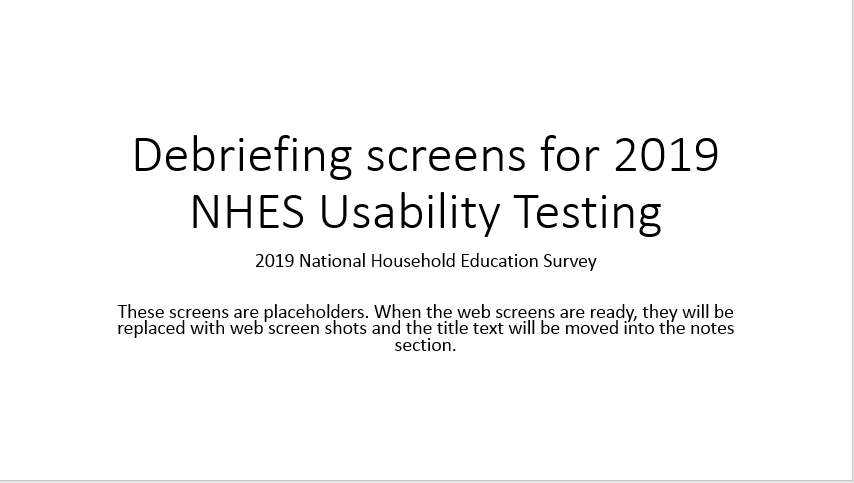

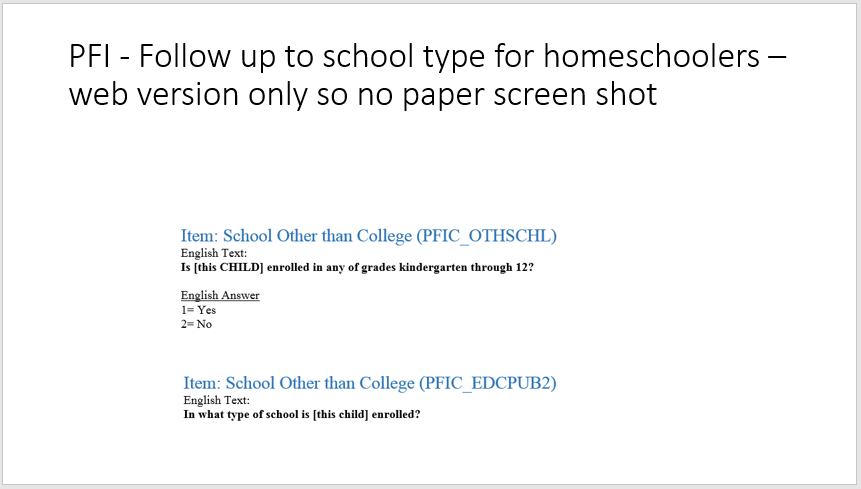





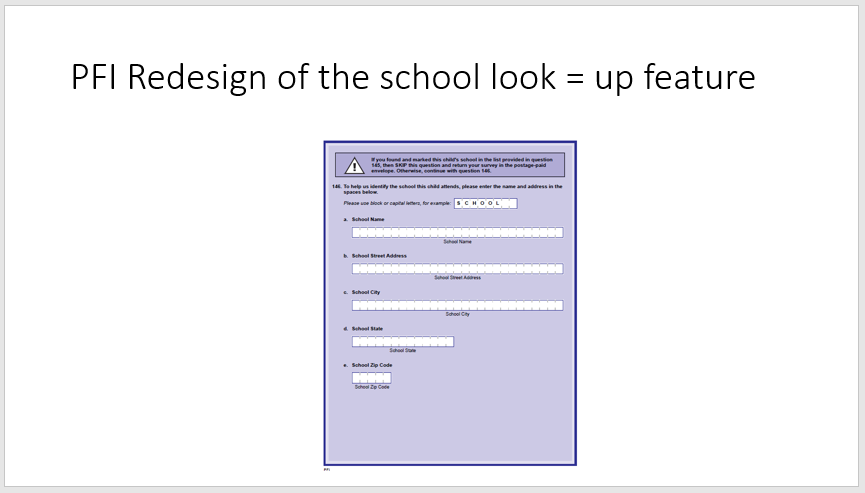

1Additional probes: Find out more about how it works for parents across different kinds of care arrangements including NO care arrangements. Please tell me more about your child care arrangements in your own words and any comments you had about the questions in this section.
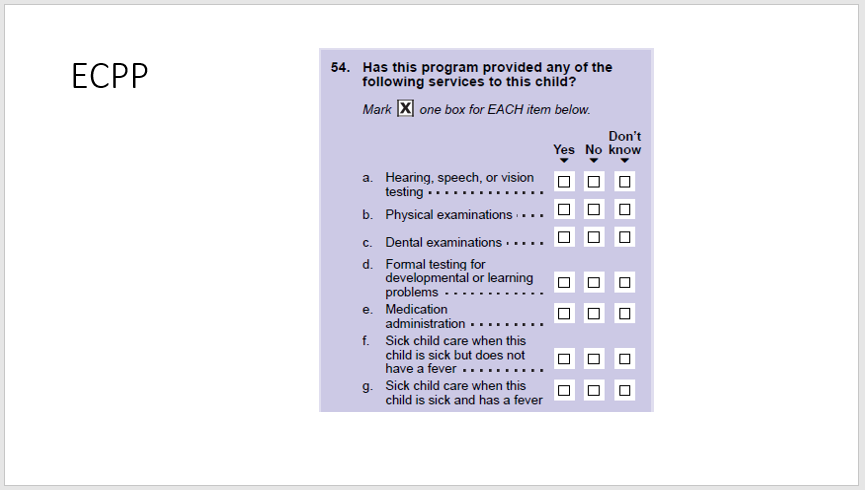


Usability Testing Protocol- Spanish translation
INTERVIEWER USABILITY TESTING SCRIPT
Muchas gracias por el tiempo que usted nos dedica hoy. Mi nombre es XX y trabajo con la Oficina del Censo. Hoy voy a trabajar con usted. En este laboratorio trabajamos evaluando cuán fáciles o difíciles de usar son algunos productos de la Oficina del Censo. Lo que funciona bien, lo usamos tal como está. Cuando las personas que van a usarlos, por ejemplo, personas como usted, tienen dificultad con algo, tenemos la oportunidad de arreglarlo antes de que se use con un grupo mucho más grande de personas.
Antes de empezar, aquí hay un formulario que quisiera que usted lea y firme. En él se explica el propósito de la sesión de hoy y qué derechos usted tiene como participante. También se le informa que nos gustaría grabar en video cuando usted usa el dispositivo y grabar el sonido de esta sesión para tener un registro completo de sus opiniones. Su nombre no se asociará con la grabación ni con ningún otro dato obtenido durante la sesión.
[Hand NHES consent form; give time to read and sign; sign own name and date. Show participants where the camera is and what part of the screen will be recorded. Then start recording.]
Muchas gracias.
Bien, perfecto.
Hoy le vamos a pedir que realice varias tareas. La primera tarea es completar un cuestionario. En ello se obtiene información sobre usted.
[Have participant fill out the usability background materials: demographic questionnaire on the laptop (for English) and on paper for Spanish—simply move away from where they are answering so they don’t feel like we are looking over their shoulder.]
Muchas gracias.
La secunda parte de esta sesión es para que nos ayude evaluar el diseño de una encuesta, en la que estamos trabajando para El Departamento de Educación del los Estados Unidos. Nos ayudará evaluar la Encuesta Nacional de Hogares y Educación (NHES) por completarla usando [su teléfono celular/esta computadora portátil].
Si tiene alguna dificultad mientras completa el cuestionario, no piense que es culpa suya. Si hay alguna dificultad será debido al diseño de la encuesta por internet, y no a sus habilidades o su capacidad. Vamos a usar sus comentarios y experiencias, así como los comentarios y experiencias de otros participantes como ayuda para mejorar la encuesta. Yo no soy la persona que diseñó la encuesta por internet, así que no sienta que debe callarse sus opiniones para no ser descortés conmigo. Agradecemos que nos ayude a asegurarnos que la encuesta por internet funciona bien para todo el mundo.
THINK ALOUD: Me gustaría que usted conteste las preguntas exactamente como lo haría si estuviera en su casa, pero con una diferencia importante. Quiero que usted vaya pensando en voz alta mientras va contestando las preguntas. Me interesan sus respuestas, pero también me interesa el proceso en su mente mientras contesta las preguntas. Quisiera que me diga todo lo que está pensando, haciendo y sintiendo mientras va contestando cada pregunta.
Practice Think Aloud
Vamos a hacer una práctica antes de empezar: Por favor, piense en voz alta mientras va contestando la pregunta, ¿cuántas ventanas hay en su casa?
[Probe if they fall silent; if they just give a number ask them to do it again but this time so that you can understand how they came up with the number; after they finish the think-aloud exercise, explain why we are asking them to do this, e.g., if the Census was interested in the number of windows, which we are not, but if we were, and someone was looking at their sliding glass door and wondered aloud that they didn’t know if they should include it or not, them saying those words would clue us in that we needed to fix our question, make it clear that sliding glass doors should be included, etc.
Probes that will be used in study
Keep talking
Um-hum?
What are you thinking?
Muy bien, eso es lo que quiero que usted haga durante la sesión. Le recordaré que piense en voz alta si se queda callado(a).
Interview – Starting with Invitation letter
[Hand participant the mailing materials (invitation letter with their user name/ID info. Make certain to write down the PIN or any information that user may need later in survey]
Este es un ejemplo de materiales que usted recibiría por correo si su dirección fuera seleccionada para participar en la encuesta. Imagina que recibió esto a su hogar. Por favor tome un momento para leerlo. Fíjese que la dirección no es la verdadera dirección donde usted vive. Si usted recibiera el cuestionario en su hogar, los materiales tendrían su verdadera dirección. Como no podemos replicar eso para las entrevistas que hacemos en el laboratorio, imagínese que esta carta/tarjeta llegó a su dirección y que la dirección que aparece en el cuestionario es la de su casa.
Esta es la única parte del estudio en la que no usamos la realidad. Por favor, conteste las preguntas del cuestionario con la información de su vida real.
Laptop/Mobile: Por favor procede a hacer lo que la carta le pide para empezar con le encuesta. Recuerde que me interesa lo que tiene que decir mientras contesta las preguntas.
{Spanish-only}
[If respondent tries to complete the survey in English without toggling to the Spanish version, say: “Por favor espere. Esta encuesta está disponible en español. ¿Puede usted encontrar la manera para cambiar el idioma a español?” Let the respondent attempt to toggle the language, and assist them if needed to ensure they complete the interview in Spanish.]
Interruption – Log out
[STOP Respondent after they entered initial screener data and ask them to pretend that they had to leave the instrument to do something else.]
Ahora me gustaría que imaginara que algo ha ocurrido y que tiene que dejar esto, así como está. Por ejemplo, imagine que se acaba de recordar que tiene que recoger algo de la tienda. ¿Qué haría?
[Once they are exited, then ask them to resume.]
Ahora me gustaría que imaginara que usted está listo(a) para continuar trabajando en la encuesta. ¿Qué haría?
[Interviewer instruction: Note what participant does if they don’t have their PIN. If they cannot enter with verification questions, give the respondent their PIN.]
FAQ Interruption
[Interruption for FAQ or Help. After they have started into the first topical part (Q60 for ECPP (prior to finding and choosing care or Q58 for PFI)]
Ahora me gustaría que imaginara que se le ocurre una pregunta acerca de esta encuesta. Usted quisiera saber cuánto tiempo tomará completar esta encuesta. ¿Qué haría?
Satisfaction Questions
After final SUBMIT is clicked, have participant answer satisfaction questions.
Ahora quisiera que contestara estas preguntas sobre cuán tan satisfecho estuvo usted con el cuestionario que acaba de completar
[Open the satisfaction survey on the laptop and have participant answer the questions.]
Debriefing Questions
Debriefing: Ask all the probes using a PowerPoint slide with those screens. We will skip the screens that the participant did not see.
La próxima tarea es en la computadora portátil. Vamos a revisar cada una de las pantallas que usted vio.
Each screen will have the following probe:
“Por favor, dígame más sobre su experiencia mientras contestaba la pregunta en esta pantalla.” (If there were issues you observed and the person forgets, say something like,) “Pensé que [la/lo[ [vi/escuche que dijo ]...por favor dígame más sobre lo que estaba pensando.”
Spanish-specific Debriefing Questions on the Translation
Spanish speakers will be debriefed on the exact same screens as the English speakers, including the same generic probes. These screens are provided in English immediately before this section. Additionally, Spanish speakers will be debriefed on additional screens to determine if there are translation issues.
SCREENER – SPANISH: NHES-11BE(S)(01/17/2018)
Q1: Instruction to return the survey if not eligible (p.7)
Probe: Por favor dígame, en sus propias palabras, lo que las instrucciones al lado derecho de de la “opción no” le están pidiendo hacer.
[In your own words, please tell me more about what the instructions placed on the right of the “no” option are asking you to do].
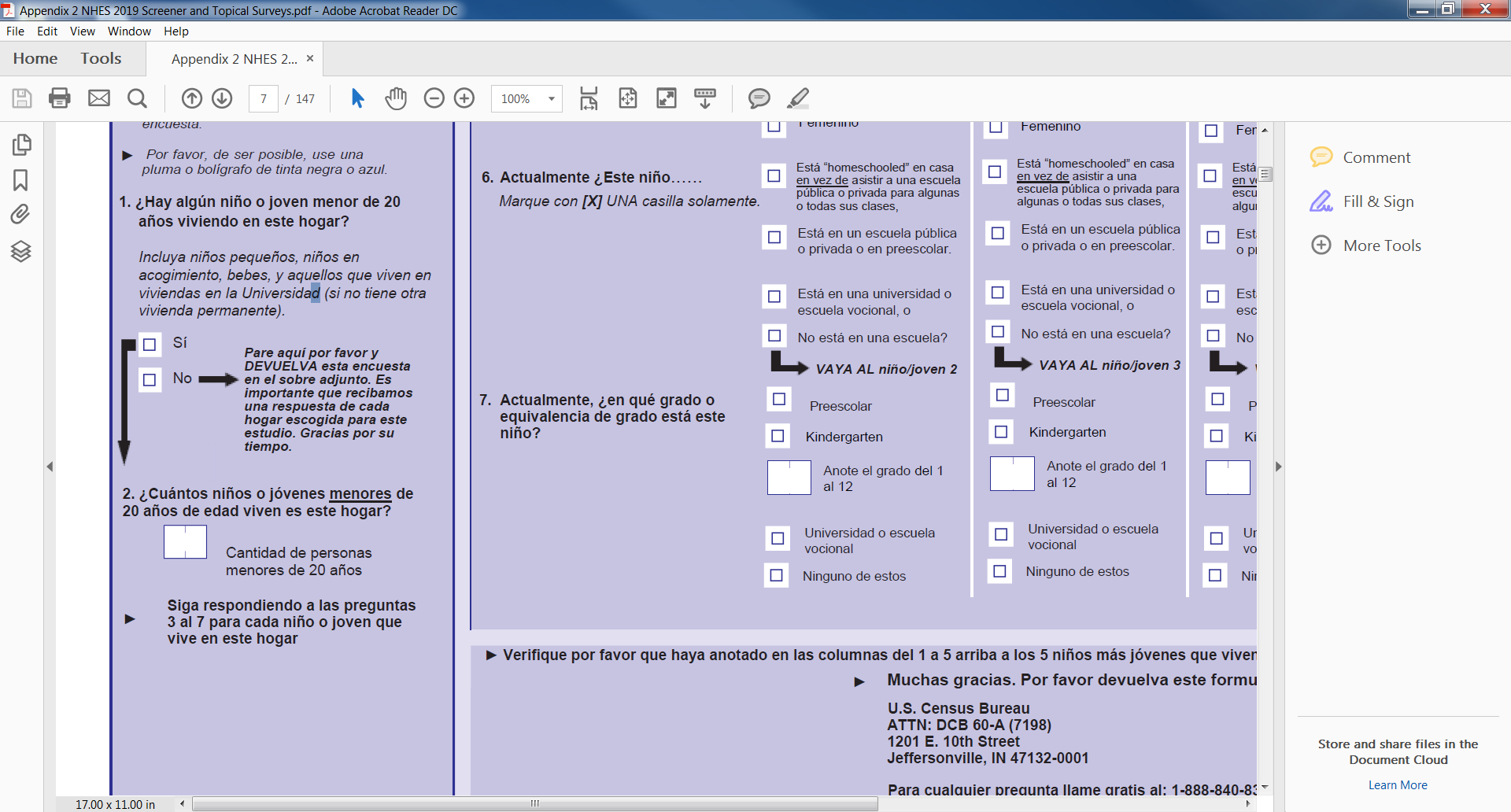
Q2: Roster (p.7)
Probe: ¿Cómo decidió en sus respuesta a estas pregunta? [Tell me more about how you answered this question. ]
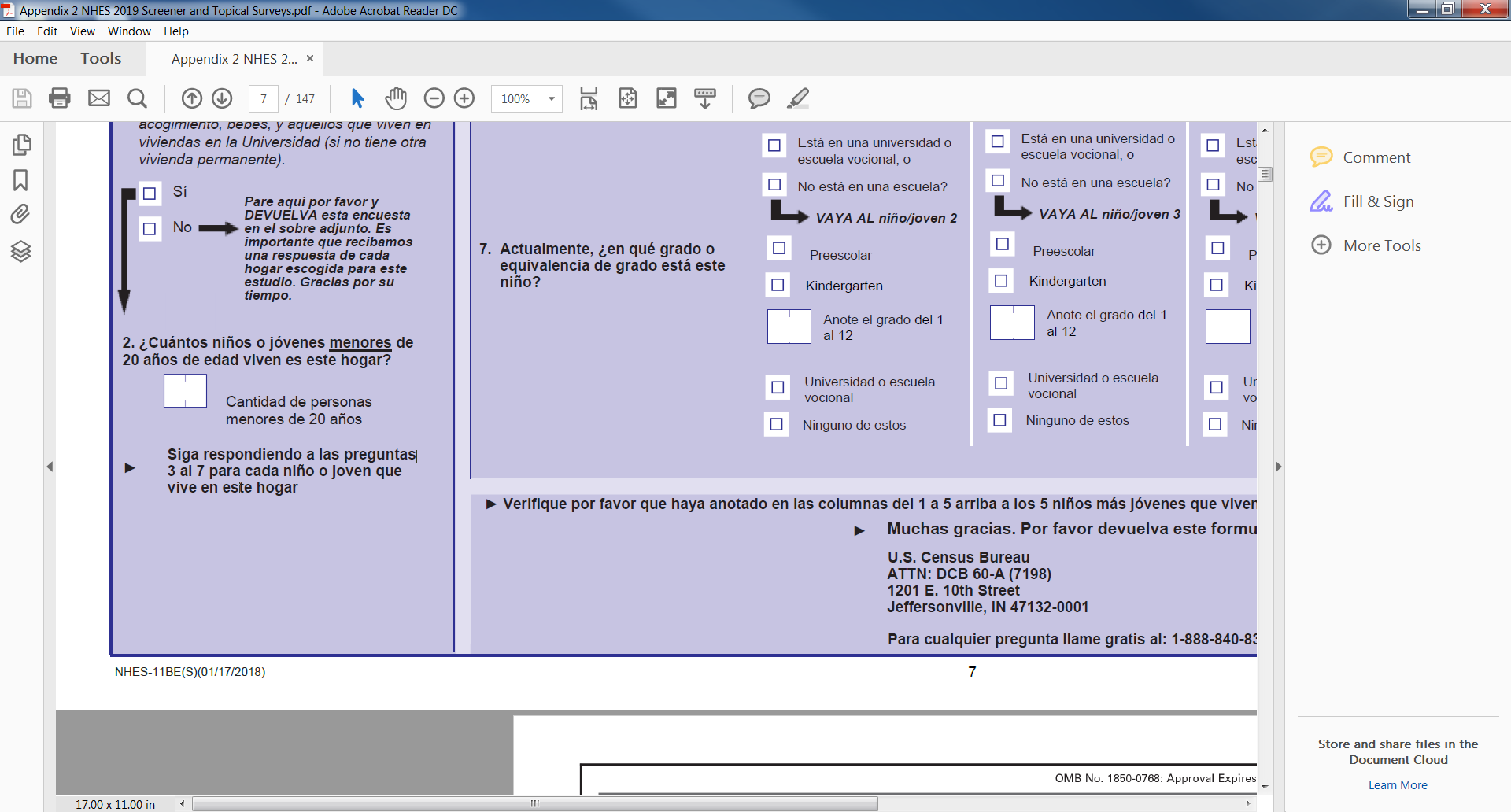
Q6: Homeschooled, not in school and vocional (p.7)
[Researcher note: “vocional” is a typo in the paper instrument]
Probes: ¿Cómo decidió en sus respuesta a estas pregunta? [Tell me more about how you answered this question. ]
Por favor dígame, en sus propias palabras, lo que significa “homeschooled” en casa.
[In your own words, please tell me what “homeschooled at home” means to you].
Por favor dígame, en sus propias palabras, lo que significa “escuela vocional.”
[In your own words, please tell me what “vocational school” means to you]
Por favor dígame, en sus propias palabras, lo que significa “no está en una escuela.”
[In your own words, please tell me what “not in school?” means to you]

Q7: Vocional
[Researcher note: This is a typo in the paper instrument]
Probes: Por favor dígame, en sus propias palabras, lo que significa “escuela vocional.”
[In your own words, please tell me what “vocational school” means to you]

Mailing out
Probe: Por favor dígame, en sus propias palabras, lo que significa “franqueo prepagado.”
[In your own words, please tell me what “postage paid” means to you]
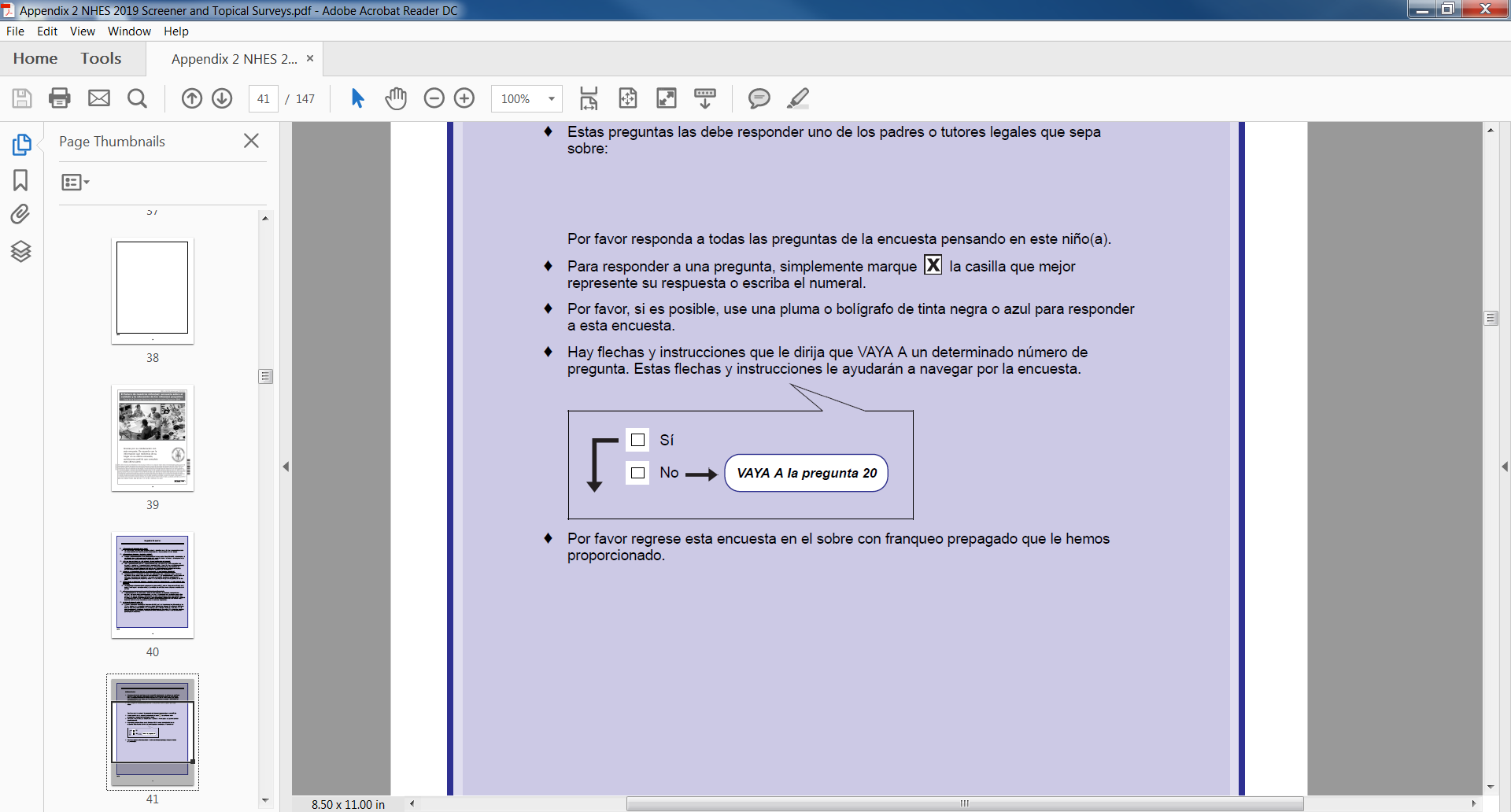
NHES-ECPP(S) (03/26/2018) Version 1.
Instructions to Q1 (p. 42)
Probe: Por favor dígame, en sus propias palabras, lo que significa “tutores legales.”
[In your own words, please tell me what “legal guardian” means to you]

Daycare arrangements: Q18 (p. 45)
Probe: Por favor dígame, en sus propias palabras, lo que le pide esta pregunta.
[In your own words, please tell me more about what this question is asking you to do].

Q27: Provider (p. 46)
Probes: Por favor dígame, en sus propias palabras, lo que le pide esta pregunta. ? [In your own words, please tell me more about what this question is asking you to do].
Por favor dígame, en sus propias palabras, lo que significa “proveedor.” [In your own words, please tell me what “provider” means to you]
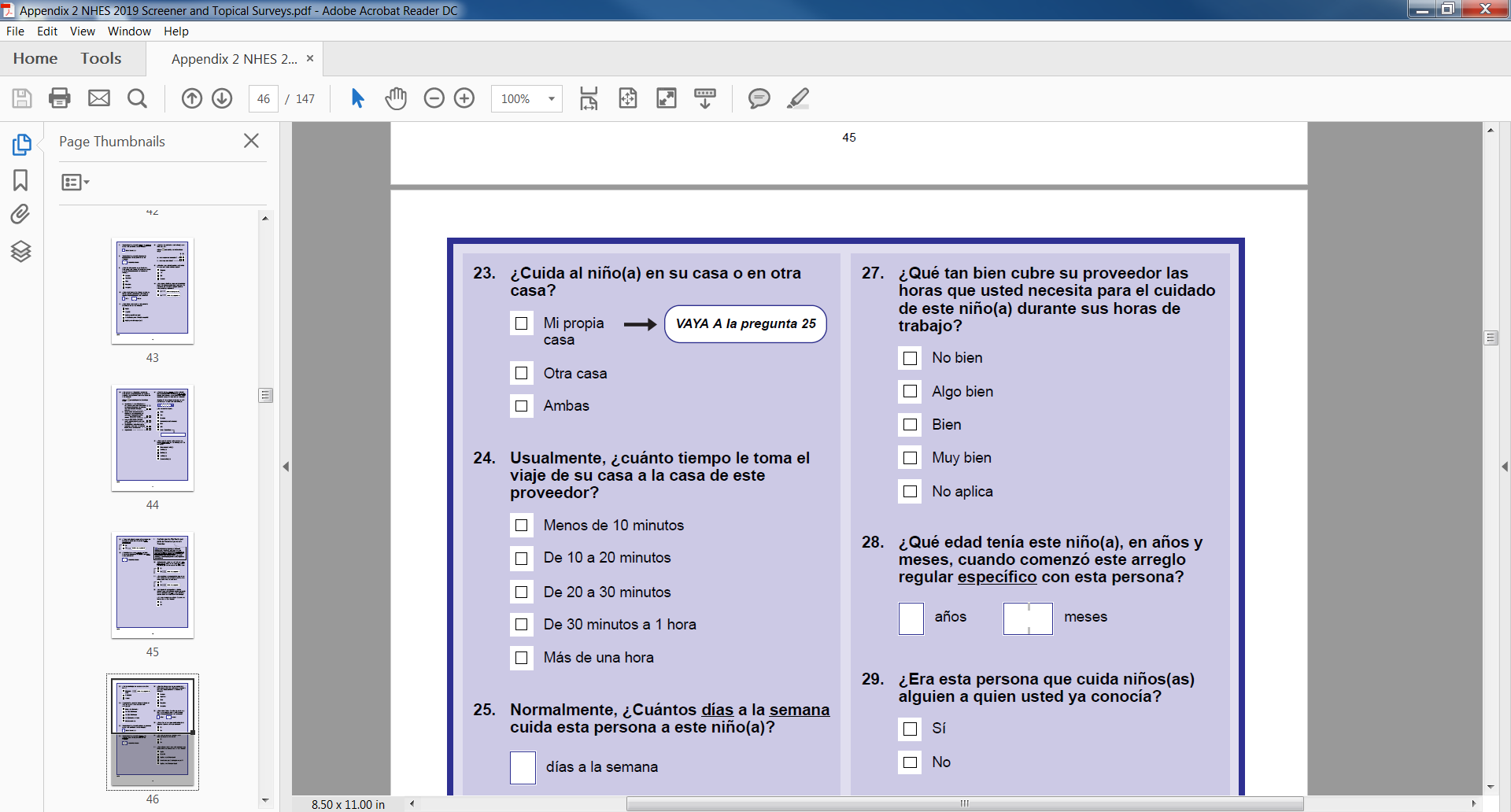
Q39: Regularity (p. 48)
[Researcher note: Look out for difficulty operationalizing time.]
Probes: Por favor dígame, en sus propias palabras, lo que le pide esta pregunta. [In your own words, please tell me more about what this question is asking you to do].
Por favor dígame, en sus propias palabras, lo que significa “con regularidad.” [In your own words, please tell me what “regularidad” means to you]
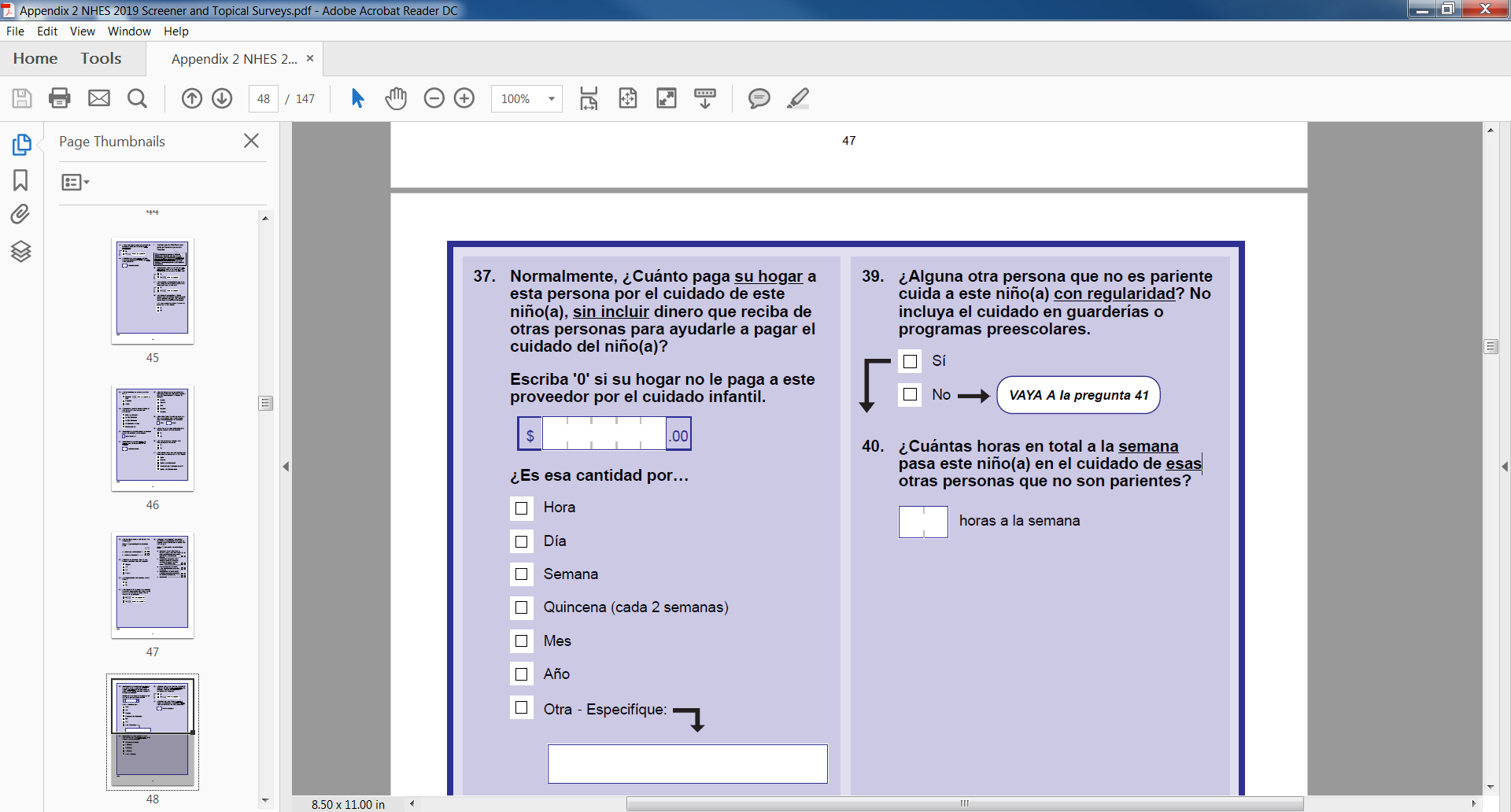
Q46 & Q61: Early Head Start (p. 49 & p. 52)
Probes: Por favor dígame, en sus propias palabras, lo que le pide esta pregunta. [In your own words, please tell me more about what this question is asking you to do].
Por favor dígame, en sus propias palabras, lo que significa “Head Start o de Early Head Start.” [In your own words, please tell me what “Head Start o de Early Head Start” means to you]


Q66: Lack of vacancies (p. 53)
Probes: Por favor dígame, en sus propias palabras, lo que le pide esta pregunta. . [In your own words, please tell me more about what this question is asking you to do].
Por favor dígame, en sus propias palabras, lo que significa “falta de vacancias.” [In your own words, please tell me what “lack of vacancies” means to you]

Q69h: Ranking (p. 55)
Probes: Por favor dígame, en sus propias palabras, lo que le pide esta pregunta. . [In your own words, please tell me more about what this question is asking you to do].
Por favor dígame, en sus propias palabras, lo que significa “ranking/clasificación.” [In your own words, please tell me what “ranking/classification” means to you]
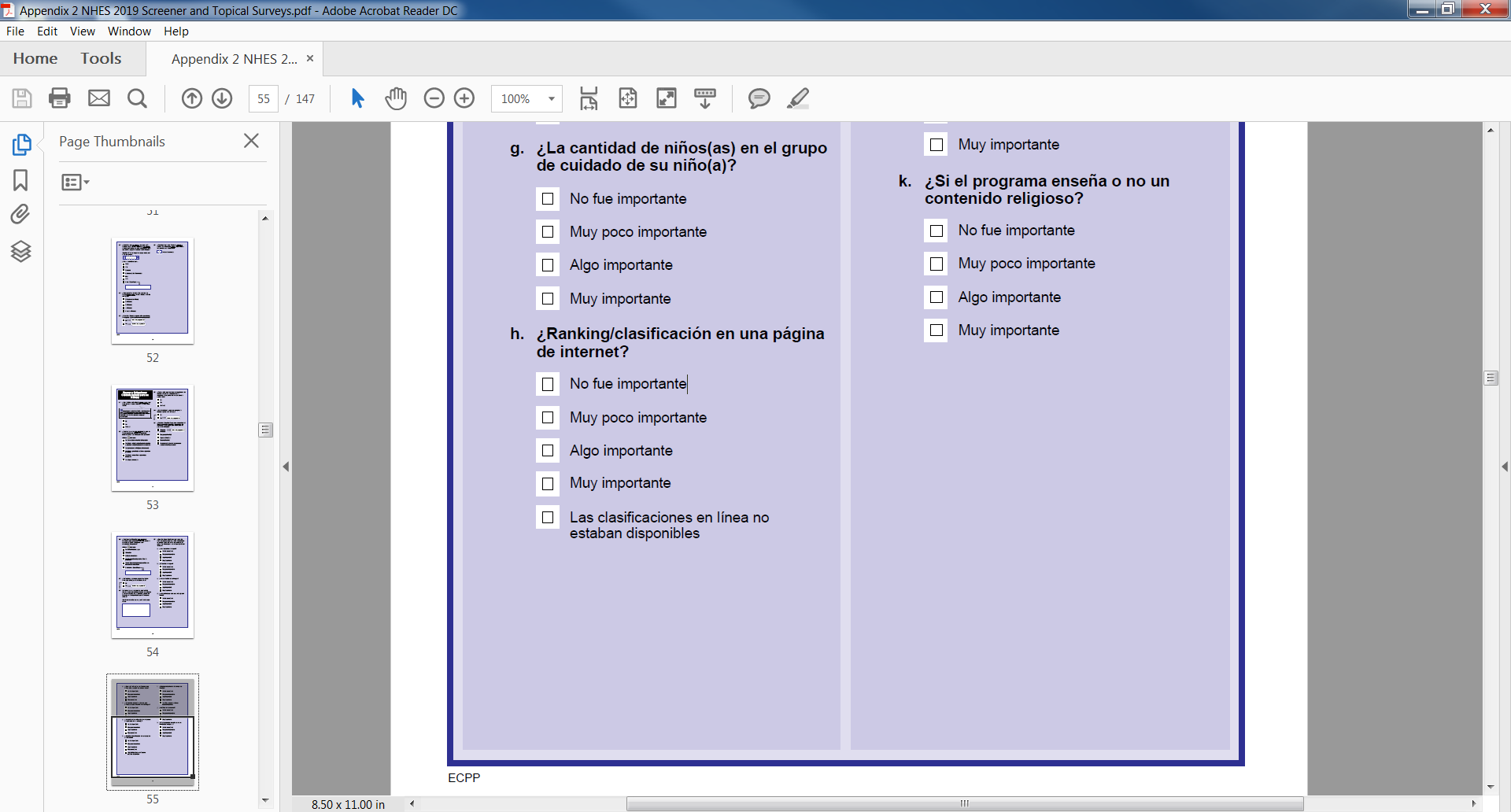
Q86: Risk. (Si el niño(a) es menor de tres años) ¿Le ha dicho un profesional de la salud, la educación o de intervención temprana que este niño(a) "está en riesgo" de tener un retraso considerable del desarrollo? (p.58)
[Researcher note: Look out for misunderstandings regarding magnitude of problems]
Probe: ¿Cómo decidió en sus respuestas a esta pregunta? [Tell me more about how you answered this question].
Q88: Services. ¿Está este niño(a) recibiendo servicios de un Plan de Servicio Familiar Individualizado (IFSP), Programa de Educación Individualizado (IEP) o plan de servicios? (p. 59)
Probe: ¿Cómo decidió en sus respuestas a estas preguntas? [Tell me more about how you answered this question].
Q95: Reporting age as zero. ¿Qué edad tenía este niño(a) cuando se mudó por primera vez a uno de los 50 estados de los Estados Unidos o al Distrito de Columbia? Si fue menor de un año, por favor escriba "0"
Probes: ¿Cómo decidió en sus respuestas a estas preguntas? [Tell me more about how you answered this question].
Por favor dígame, en sus propias palabras, lo que significa “por favor escriba "0."” [In your own words, please tell me what “please write down zero” means to you]
Q102. Education in other languages. Actualmente, ¿asiste este niño(a) a clases de inglés como segundo idioma, educación bilingüe o a un programa de inmersión al inglés?
Probes: ¿Cómo decidió en sus respuestas a estas preguntas? [Tell me more about how you answered this question].
Por favor dígame, en sus propias palabras, lo que significa “programa de inmersión al inglés” [In your own words, please tell me what “English immersion program” means to you]
Q108. ¿Es este padre o tutor legal de sexo masculino o femenino?
[Researcher note: There is no indication for mother so not sure how participant will react. Will they only answer male?]
Probe: ¿Cómo decidió en sus respuestas a estas preguntas? [Tell me more about how you answered this question].
Q120. Time estimation. ¿Más o menos cuántas horas a la semana trabaja este padre o tutor legal normalmente por pagos o ingresos,contando todos los trabajos? (p. 65) and Q138 (p.68)
Probe: ¿Cómo decidió en sus respuestas a estas preguntas? [Tell me more about how you answered this question].
Q130. Parental language. ¿Qué idioma habla este padre o tutor legal más en el hogar actualmente? (p. 67) and Q101 (p. 135)
Probes: ¿Cómo decidió en sus respuestas a estas preguntas? [Tell me more about how you answered this question].
144. Tenure. Este hogar o apartamento…Marque UNO solo.
¿Es propiedad de alguien en el hogar o la está pagando alguien en este hogar?
¿Es alquilada por alguien en este hogar?
¿Es ocupada por algún otro tipo de acuerdo? (p. 70)
[Researcher note: The translation is different from the source: “Owned or being bought by someone in this household”]
Probes: ¿Cómo decidió en sus respuestas a estas preguntas? [Tell me more about how you answered this question].
Por favor dígame, en sus propias palabras, lo que significa “propiedad de alguien en el hogar o la está pagando alguien en este hogar” [In your own words, please tell me what “owned or somebody at home is paying for it” means to you]
NHES-PFI(S)
Q2. School types (p. 113)

Probe: ¿Cómo decidió en sus respuestas a estas preguntas? [Tell me more about how you answered these questions].
Q3. Homeschooling (p. 113)

[Researcher note: There is not consistency in this term. Sometimes they use “homeschool” in English and here the translated term. Need for a copy editor.]
Probes: ¿Cómo decidió en sus respuestas a estas preguntas? [Tell me more about how you answered this question].
Por favor dígame, en sus propias palabras, lo que significa “Educado en casa”? [In your own words, please tell me what “homeschooled” means to you]
Q6. Co-op. ¿Recibe este niño(a) alguna parte de su instrucción en un grupo o cooperativa local para la educación en casa? (P. 114)
Probe: Por favor dígame, en sus propias palabras, lo que significa “grupo o cooperativa local para la educación en casa” [In your own words, please tell me what “owned or somebody at home is paying for it” means to you]
Q9. Cyber. ¿Está inscrito este niño(a) en cursos online, virtuales, o cyber? (P. 114)
Probe: Por favor dígame, en sus propias palabras, lo que significa “cursos online, virtuales, o cyber” [In your own words, please tell me what “online, virtual and cyber courses” mean to you]
Q10a. Advanced placement (p. 115)
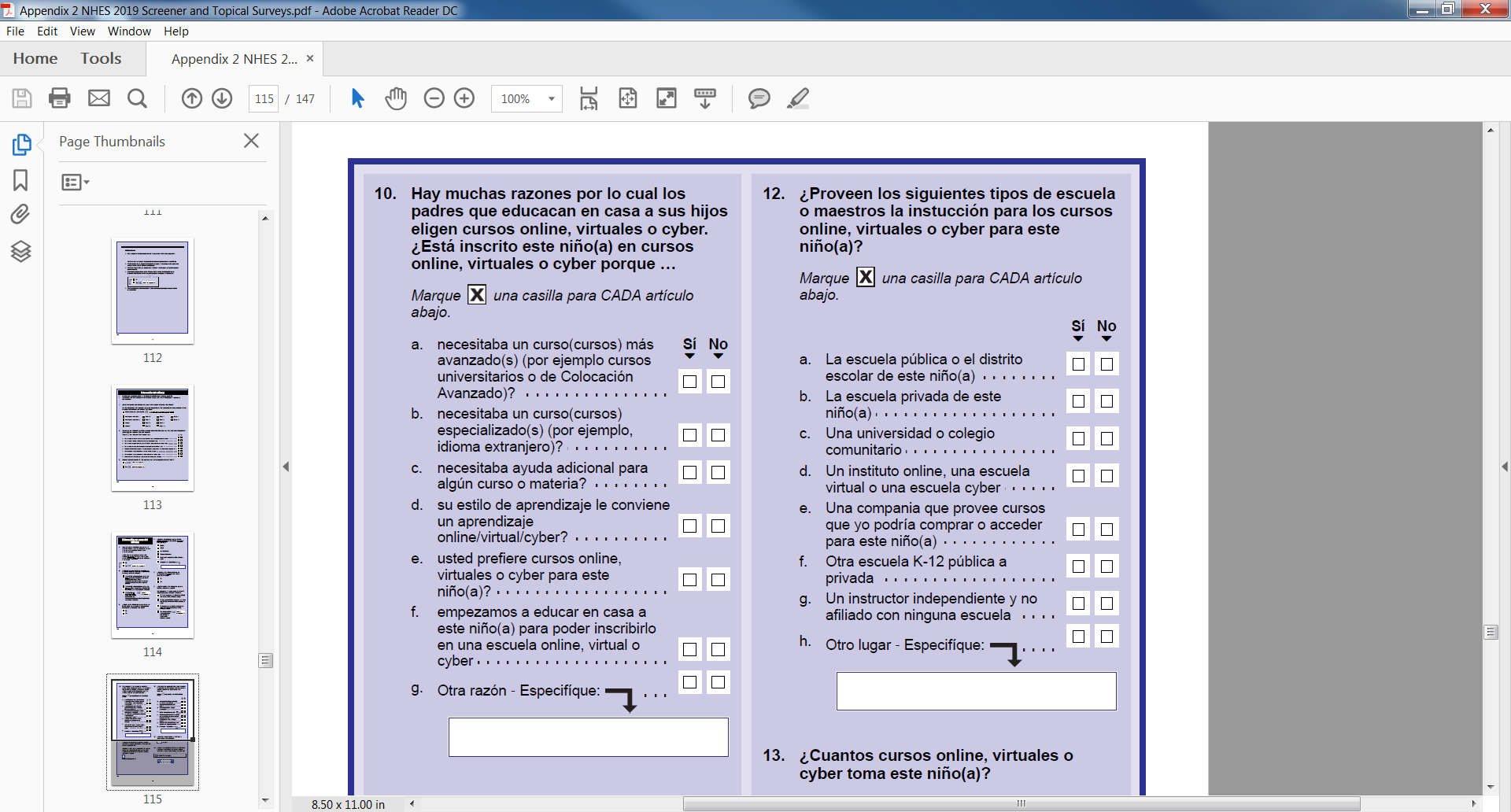
Probes: ¿Cómo decidió en sus respuestas a estas preguntas? [Tell me more about how you answered this question].
Por favor dígame, en sus propias palabras, lo que significa “Colocación Avanzado”? [In your own words, please tell me what “advancement placement” means to you]
Q16. Curriculum (p. 116)

Probes: ¿Cómo decidió en sus respuestas a estas preguntas? [Tell me more about how you answered this question].
Por favor dígame, en sus propias palabras, lo que significa “currículo”? ” [In your own words, please tell me what “curriculum” means to you]
Q21 Classes (P. 118): 21. Pensando en los niveles típicos de grados, ¿para qué grados recibió este niño(a) educación en casa, al menos para algunas clases o asignaturas?
[Researcher Note: Inconsistent translation of classes in Spanish: they use “asignaturas”, clases and sometimes “materias” (see q24)]
Probe: Por favor dígame, en sus propias palabras, lo que significa “asignaturas”?
.
Q24 (p.119): ¿En la semana más reciente en la cual este niño(a) fue educado en casa, cuales materias fueron enseñados durante ese periodo?
Probe: Por favor dígame, en sus propias palabras, lo que significa “materias”? [In your own words, please tell me what “subjects/classes” means to you]
Q33: ¿Es esta escuela una escuela especializada (magnet school) o asiste este niño(a) un programa especializada (magnet program)?
Probe: Por favor dígame, en sus propias palabras, lo que le pide esta pregunta. [Tell me more about how you answered this question].
Q38D. STEM and language immersion (P. 121)
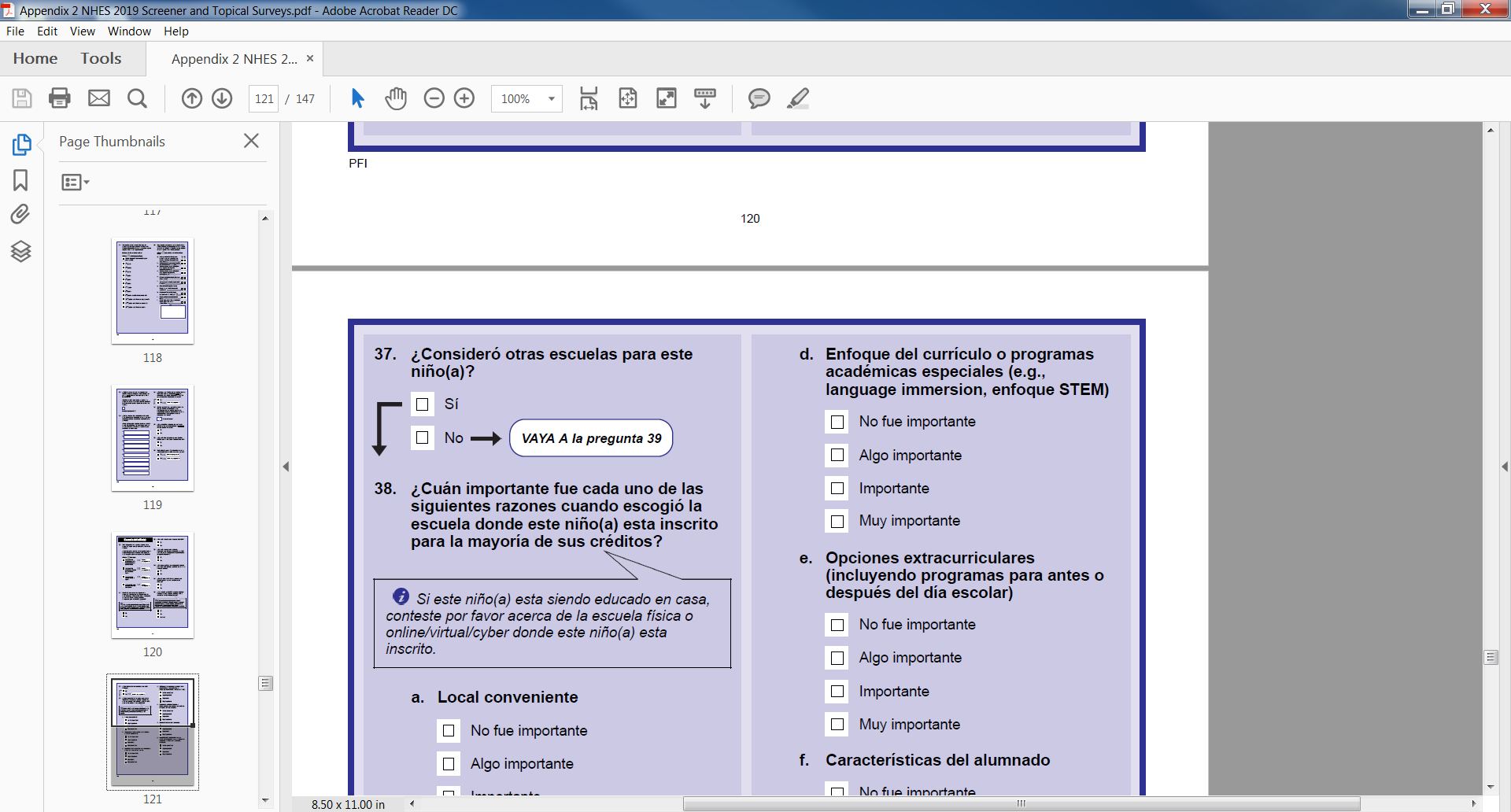
[Researcher Note: Is this wording intentionally left in English?] Probes: Por favor dígame, en sus propias palabras, lo que significa “language immersion”? ”? [In your own words, please tell me what “language immersion” means to you]
Probes: Por favor dígame, en sus propias palabras, lo que significa “language immersion”? ”? [In your own words, please tell me what “language immersion” means to you]
Por favor dígame, en sus propias palabras, lo que significa “STEM”? ” [In your own words, please tell me what “STEM” means to you]
Q48. ¿Cúal es la cantidad total de la matrícula y cargos para todas las clases online,
virtuales o cyber que toma este niño(a)? (p. 124)
Probes: Por favor dígame, en sus propias palabras, lo que le pide esta pregunta. [Tell me more about how you answered this question].
Por favor dígame, en sus propias palabras, lo que significa “matrícula”? [In your own words, please tell me what “tuition” means to you]
Q124 (P.139) ¿Tiene esta escuela intérpretes que hablan la lengua materna de este padre o tutor legal para reuniones en la escuela o conferencias entre padres y maestros?
Por favor dígame, en sus propias palabras, lo que le pide esta pregunta. [Tell me more about how you answered this question].
Additional Debriefing Questions
Is there anything else you’d like to mention that we haven’t talked about?
Additional Debriefing Questions – Spanish translation
¿Hay algo más que le gustaría mencionar y de que aún no hemos hablado?
Spanish-specific Debriefing Questions on the Translation
Spanish speakers will be debriefed on the exact same screens as the English speakers, including the same generic probes. These screens are provided in English immediately before this section. Additionally, Spanish speakers will be debriefed on additional screens to determine if there are translation issues.
SCREENER – SPANISH: NHES-11BE(S)(01/17/2018)
Q1: Instruction to return the survey if not eligible (p.7)
Probe: Por favor dígame, en sus propias palabras, lo que las instrucciones al lado derecho de de la “opción no” le están pidiendo hacer.
[In your own words, please tell me more about what the instructions placed on the right of the “no” option are asking you to do].

Q2: Roster (p.7)
Probe: ¿Cómo decidió en sus respuesta a estas pregunta? [Tell me more about how you answered this question. ]

Q6: Homeschooled, not in school and vocional (p.7)
[Researcher note: “vocional” is a typo in the paper instrument]
Probes: ¿Cómo decidió en sus respuesta a estas pregunta? [Tell me more about how you answered this question. ]
Por favor dígame, en sus propias palabras, lo que significa “homeschooled” en casa.
[In your own words, please tell me what “homeschooled at home” means to you].
Por favor dígame, en sus propias palabras, lo que significa “escuela vocional.”
[In your own words, please tell me what “vocational school” means to you]
Por favor dígame, en sus propias palabras, lo que significa “no está en una escuela.”
[In your own words, please tell me what “not in school?” means to you]

Q7: Vocional
[Researcher note: This is a typo in the paper instrument]
Probes: Por favor dígame, en sus propias palabras, lo que significa “escuela vocional.”
[In your own words, please tell me what “vocational school” means to you]

Mailing out
Probe: Por favor dígame, en sus propias palabras, lo que significa “franqueo prepagado.”
[In your own words, please tell me what “postage paid” means to you]

NHES-ECPP(S) (03/26/2018) Version 1.
Instructions to Q1 (p. 42)
Probe: Por favor dígame, en sus propias palabras, lo que significa “tutores legales.”
[In your own words, please tell me what “legal guardian” means to you]

Daycare arrangements: Q18 (p. 45)
Probe: Por favor dígame, en sus propias palabras, lo que le pide esta pregunta.
[In your own words, please tell me more about what this question is asking you to do].

Q27: Provider (p. 46)
Probes: Por favor dígame, en sus propias palabras, lo que le pide esta pregunta. ? [In your own words, please tell me more about what this question is asking you to do].
Por favor dígame, en sus propias palabras, lo que significa “proveedor.” [In your own words, please tell me what “provider” means to you]

Q39: Regularity (p. 48)
[Researcher note: Look out for difficulty operationalizing time.]
Probes: Por favor dígame, en sus propias palabras, lo que le pide esta pregunta. [In your own words, please tell me more about what this question is asking you to do].
Por favor dígame, en sus propias palabras, lo que significa “con regularidad.” [In your own words, please tell me what “regularidad” means to you]

Q46 & Q61: Early Head Start (p. 49 & p. 52)
Probes: Por favor dígame, en sus propias palabras, lo que le pide esta pregunta. [In your own words, please tell me more about what this question is asking you to do].
Por favor dígame, en sus propias palabras, lo que significa “Head Start o de Early Head Start.” [In your own words, please tell me what “Head Start o de Early Head Start” means to you]


Q66: Lack of vacancies (p. 53)
Probes: Por favor dígame, en sus propias palabras, lo que le pide esta pregunta. . [In your own words, please tell me more about what this question is asking you to do].
Por favor dígame, en sus propias palabras, lo que significa “falta de vacancias.” [In your own words, please tell me what “lack of vacancies” means to you]

Q69h: Ranking (p. 55)
Probes: Por favor dígame, en sus propias palabras, lo que le pide esta pregunta. . [In your own words, please tell me more about what this question is asking you to do].
Por favor dígame, en sus propias palabras, lo que significa “ranking/clasificación.” [In your own words, please tell me what “ranking/classification” means to you]

Q86: Risk. (Si el niño(a) es menor de tres años) ¿Le ha dicho un profesional de la salud, la educación o de intervención temprana que este niño(a) "está en riesgo" de tener un retraso considerable del desarrollo? (p.58)
[Researcher note: Look out for misunderstandings regarding magnitude of problems]
Probe: ¿Cómo decidió en sus respuestas a esta pregunta? [Tell me more about how you answered this question].
Q88: Services. ¿Está este niño(a) recibiendo servicios de un Plan de Servicio Familiar Individualizado (IFSP), Programa de Educación Individualizado (IEP) o plan de servicios? (p. 59)
Probe: ¿Cómo decidió en sus respuestas a estas preguntas? [Tell me more about how you answered this question].
Q95: Reporting age as zero. ¿Qué edad tenía este niño(a) cuando se mudó por primera vez a uno de los 50 estados de los Estados Unidos o al Distrito de Columbia? Si fue menor de un año, por favor escriba "0"
Probes: ¿Cómo decidió en sus respuestas a estas preguntas? [Tell me more about how you answered this question].
Por favor dígame, en sus propias palabras, lo que significa “por favor escriba "0."” [In your own words, please tell me what “please write down zero” means to you]
Q102. Education in other languages. Actualmente, ¿asiste este niño(a) a clases de inglés como segundo idioma, educación bilingüe o a un programa de inmersión al inglés?
Probes: ¿Cómo decidió en sus respuestas a estas preguntas? [Tell me more about how you answered this question].
Por favor dígame, en sus propias palabras, lo que significa “programa de inmersión al inglés” [In your own words, please tell me what “English immersion program” means to you]
Q108. ¿Es este padre o tutor legal de sexo masculino o femenino?
[Researcher note: There is no indication for mother so not sure how participant will react. Will they only answer male?]
Probe: ¿Cómo decidió en sus respuestas a estas preguntas? [Tell me more about how you answered this question].
Q120. Time estimation. ¿Más o menos cuántas horas a la semana trabaja este padre o tutor legal normalmente por pagos o ingresos,contando todos los trabajos? (p. 65) and Q138 (p.68)
Probe: ¿Cómo decidió en sus respuestas a estas preguntas? [Tell me more about how you answered this question].
Q130. Parental language. ¿Qué idioma habla este padre o tutor legal más en el hogar actualmente? (p. 67) and Q101 (p. 135)
Probes: ¿Cómo decidió en sus respuestas a estas preguntas? [Tell me more about how you answered this question].
144. Tenure. Este hogar o apartamento…Marque UNO solo.
¿Es propiedad de alguien en el hogar o la está pagando alguien en este hogar?
¿Es alquilada por alguien en este hogar?
¿Es ocupada por algún otro tipo de acuerdo? (p. 70)
[Researcher note: The translation is different from the source: “Owned or being bought by someone in this household”]
Probes: ¿Cómo decidió en sus respuestas a estas preguntas? [Tell me more about how you answered this question].
Por favor dígame, en sus propias palabras, lo que significa “propiedad de alguien en el hogar o la está pagando alguien en este hogar” [In your own words, please tell me what “owned or somebody at home is paying for it” means to you]
NHES-PFI(S)
Q2. School types (p. 113)

Probe: ¿Cómo decidió en sus respuestas a estas preguntas? [Tell me more about how you answered these questions].
Q3. Homeschooling (p. 113)

[Researcher note: There is not consistency in this term. Sometimes they use “homeschool” in English and here the translated term. Need for a copy editor.]
Probes: ¿Cómo decidió en sus respuestas a estas preguntas? [Tell me more about how you answered this question].
Por favor dígame, en sus propias palabras, lo que significa “Educado en casa”? [In your own words, please tell me what “homeschooled” means to you]
Q6. Co-op. ¿Recibe este niño(a) alguna parte de su instrucción en un grupo o cooperativa local para la educación en casa? (P. 114)
Probe: Por favor dígame, en sus propias palabras, lo que significa “grupo o cooperativa local para la educación en casa” [In your own words, please tell me what “owned or somebody at home is paying for it” means to you]
Q9. Cyber. ¿Está inscrito este niño(a) en cursos online, virtuales, o cyber? (P. 114)
Probe: Por favor dígame, en sus propias palabras, lo que significa “cursos online, virtuales, o cyber” [In your own words, please tell me what “online, virtual and cyber courses” mean to you]
Q10a. Advanced placement (p. 115)

Probes: ¿Cómo decidió en sus respuestas a estas preguntas? [Tell me more about how you answered this question].
Por favor dígame, en sus propias palabras, lo que significa “Colocación Avanzado”? [In your own words, please tell me what “advancement placement” means to you]
Q16. Curriculum (p. 116)

Probes: ¿Cómo decidió en sus respuestas a estas preguntas? [Tell me more about how you answered this question].
Por favor dígame, en sus propias palabras, lo que significa “currículo”? ” [In your own words, please tell me what “curriculum” means to you]
Q21 Classes (P. 118): 21. Pensando en los niveles típicos de grados, ¿para qué grados recibió este niño(a) educación en casa, al menos para algunas clases o asignaturas?
[Researcher Note: Inconsistent translation of classes in Spanish: they use “asignaturas”, clases and sometimes “materias” (see q24)]
Probe: Por favor dígame, en sus propias palabras, lo que significa “asignaturas”?
.
Q24 (p.119): ¿En la semana más reciente en la cual este niño(a) fue educado en casa, cuales materias fueron enseñados durante ese periodo?
Probe: Por favor dígame, en sus propias palabras, lo que significa “materias”? [In your own words, please tell me what “subjects/classes” means to you]
Q33: ¿Es esta escuela una escuela especializada (magnet school) o asiste este niño(a) un programa especializada (magnet program)?
Probe: Por favor dígame, en sus propias palabras, lo que le pide esta pregunta. [Tell me more about how you answered this question].
Q38D. STEM and language immersion (P. 121)

[Researcher Note: Is this wording intentionally left in English?] Probes: Por favor dígame, en sus propias palabras, lo que significa “language immersion”? ”? [In your own words, please tell me what “language immersion” means to you]
Probes: Por favor dígame, en sus propias palabras, lo que significa “language immersion”? ”? [In your own words, please tell me what “language immersion” means to you]
Por favor dígame, en sus propias palabras, lo que significa “STEM”? ” [In your own words, please tell me what “STEM” means to you]
Q48. ¿Cúal es la cantidad total de la matrícula y cargos para todas las clases online,
virtuales o cyber que toma este niño(a)? (p. 124)
Probes: Por favor dígame, en sus propias palabras, lo que le pide esta pregunta. [Tell me more about how you answered this question].
Por favor dígame, en sus propias palabras, lo que significa “matrícula”? [In your own words, please tell me what “tuition” means to you]
Q124 (P.139) ¿Tiene esta escuela intérpretes que hablan la lengua materna de este padre o tutor legal para reuniones en la escuela o conferencias entre padres y maestros?
Por favor dígame, en sus propias palabras, lo que le pide esta pregunta. [Tell me more about how you answered this question].
Finishing up session
[Give the respondent incentive envelope [$60], and thank them for their time and effort. Collect materials and leave or escort respondent out of the interviewing room.]
Okay, that’s all that I have today. Many thanks for your work on this project. The last thing I need you to do is sign this form that says I am giving you $60.
Finishing up session- Spanish translation
[Give the respondent incentive envelope [$60], and thank them for their time and effort. Collect materials and leave or escort respondent out of the interviewing room.]
Es todo para hoy. Muchas gracias por su trabajo en este proyecto. La última tarea que tengo para usted es que firme este formulario que dice que le estoy dando $60.
NOTES PAGES
P#___
PFI or ECPP
Characteristic of Participant:
TA:______________________
Date: _____________________
Location: Headquarters / Other :________________________
PC or Device: _____________________
WiFi or Dataplan
Browser type used:_____________________________________
Other browsers on device:________________________________
Demographics:
Description of household (circle):
Child age is less than 5 years old /
Children 5-18 in Public or Private School /
Children 5-18 in Home schooling
Spontaneous comments:
Any spontaneous comments about length of survey, repetitive questions, etc: Where did it occur?
Time in survey – minus time for vignettes
Background and Demographics Questionnaire
1. In what month and year were you born? _________________ __________________
month year
2. What is the highest grade or year of school you have completed?
 Less
than high school
Less
than high school
 Completed
high school
Completed
high school
 Some
college, no degree (indicate area of study:
____________________________________)
Some
college, no degree (indicate area of study:
____________________________________)
 Associate’s
degree (AA/AS) (indicate area of study:
__________________________________)
Associate’s
degree (AA/AS) (indicate area of study:
__________________________________)
 Bachelor’s
Degree (BA/BS) (indicate area of study:
__________________________________)
Bachelor’s
Degree (BA/BS) (indicate area of study:
__________________________________)
 Post-Bach
degree (indicate degree and area of study:
________________________________)
Post-Bach
degree (indicate degree and area of study:
________________________________)
 Male
Male
 Female
Female
4. Are you of Hispanic, Latino, or Spanish origin?
 Yes
Yes
 No
No
5. What is your race? Choose one or more races.
 White
White
 Black
or African American
Black
or African American
 American
Indian or Alaska Native
American
Indian or Alaska Native
 Asian
Asian
 Native
Hawaiian or Other Pacific Islander
Native
Hawaiian or Other Pacific Islander
Background and Demographics Questionnaire- Spanish translation
Información demográfica
1. ¿En qué mes y qué año nació usted? _________________ __________________
mes año
2. ¿Cuál es el nivel o año escolar más alto que ha completado?
 Menos
de secundaria (high school)
Menos
de secundaria (high school)
 Terminó
secundaria (high school)
Terminó
secundaria (high school)
 Algunos
cursos de universidad, sin diploma (indique el área de
estudio: ________________________)
Algunos
cursos de universidad, sin diploma (indique el área de
estudio: ________________________)
 Titulo
de diplomado
(Associate, AA/AS) (indique
el área de estudio:____________________________)
Titulo
de diplomado
(Associate, AA/AS) (indique
el área de estudio:____________________________)
 Título
de licenciatura (BA/BS) (indique el área de estudio:
__________________________________)
Título
de licenciatura (BA/BS) (indique el área de estudio:
__________________________________)
 Título
de posgrado (indique el título y el área de estudio:
________________________________)
Título
de posgrado (indique el título y el área de estudio:
________________________________)
3. ¿Es usted de sexo masculino o femenino?
 Masculino
Masculino
 Femenino
Femenino
4. ¿Es usted de origen hispano, latino o español?
 Sí
Sí
 No
No
5. ¿Cuál es su raza? Elija una raza o más de una.
 Blanca
Blanca
 Negra
o africana americana
Negra
o africana americana
 India
americana o nativa de Alaska
India
americana o nativa de Alaska
 Asiática
Asiática
 Nativa
de Hawaii o de otra de las islas del Pacífico
Nativa
de Hawaii o de otra de las islas del Pacífico
Questionnaire for User Interaction Satisfaction (QUIS)
Please Note: The questionnaire will be electronic with word labels on either end of 7 radio buttons. See image below for an idea of what the final format will look like.

Unpleasant to Pleasant
|
Never to Always
|
Never to Always
|
Barely legible to Very legible
|
Never to Always
|
Hard to understand to Easy to understand
|
Never bothered me to Always bothered me
|
Confusing to Clear
|
Difficult to Easy
|
Never to Always
|
11. Additional Comments__________________________________________________________________
|
Questionnaire for User Interaction Satisfaction (QUIS)- Spanish translation
Desagradable a Agradable
|
Nunca a Siempre
|
Nunca a Siempre
|
Apenas legible a Bastante legible
|
Nunca a Siempre
|
Difícil de entender a Fácil de entender
|
Nunca me molestó a Siempre me molestó
|
Confusas a Claras
|
Difícil a Fácil
|
Nunca a Siempre
|
11. Comentarios addicionales__________________________________________________________________
|
1 At the Census Bureau, participants are asked Spanish-specific screening questions on topics like indigenous heritage (which makes up the majority of racial diversity seen among participants), language proficiency, household composition (related versus unrelated), etc. because the answers provide demographic diversity context for each project. This screener is a typical, approved Census screener (OMB# 0607-0725) used in every project. When Spanish respondents call a recruiter, Census does not know in advance which project they are calling about and cannot only ask them screening questions related to a particular project, but need to ask the caller this generic screener and then select them the project for which the caller is most suited.
2 At the Census Bureau, participants are asked Spanish-specific screening questions on topics like indigenous heritage (which makes up the majority of racial diversity seen among participants), language proficiency, household composition (related versus unrelated), etc. because the answers provide demographic diversity context for each project. This screener is a typical, approved Census screener (OMB# 0607-0725) used in every project. When Spanish respondents call a recruiter, Census does not know in advance which project they are calling about and cannot only ask them screening questions related to a particular project, but need to ask the caller this generic screener and then select them the project for which the caller is most suited.
| File Type | application/vnd.openxmlformats-officedocument.wordprocessingml.document |
| Author | Low, Kathryn (Temp) |
| File Modified | 0000-00-00 |
| File Created | 2021-01-20 |
© 2025 OMB.report | Privacy Policy